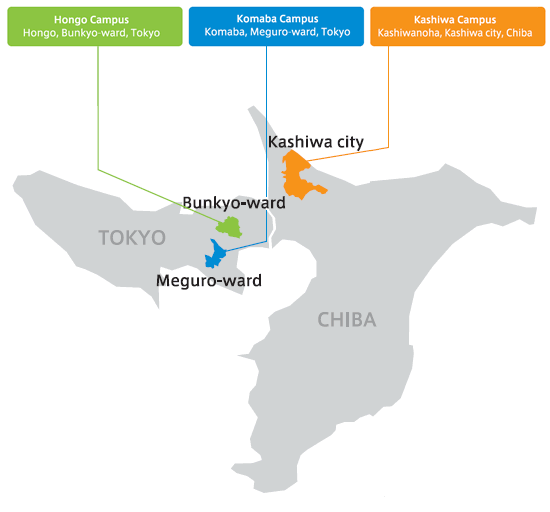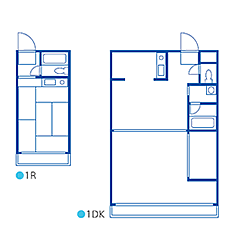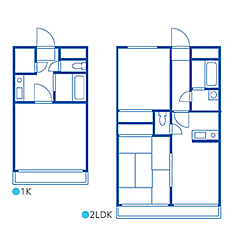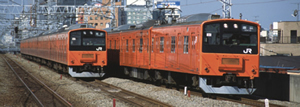Housing Situation in Tokyo

Including research institutes and observatories, UTokyo has over 50 sites all across Japan. Over half of these facilities are located in Tokyo and the surrounding Kanto region. We will explain here the housing situation for areas where three of the main campuses are located.

◆ Hongo Campus: Hongo, Bunkyo-ward, Tokyo
◆ Komaba Campus: Komaba, Meguro-ward, Tokyo
◆ Kashiwa Campus: Kashiwanoha, Kashiwa city, Chiba
![]()
The Hongo campus is located in an area with rich culture and history, intertwined with a college town feel. The Bunkyo-ward has been selected as one of the best areas to live in Japan, and is known for its safety, medical facilities, and good access to high level of education. Komaba campus, located near Shibuya and Roppongi, is surrounded with nature and is a quiet residential area. Meguro-ward, like Bunkyo-ward, is also a very popular area to live in. Kashiwa campus is located in Kashiwa city of Chiba prefecture, approximately 30 km east of Tokyo. Since 2005, the “Tsukuba Express,” a new high-speed rail line, runs between Kashiwa and Akihabara in Tokyo. Kashiwa district is a developing area with new stations being additionally built to supplement existing ones.
Housing near Hongo or Komaba campus

Housing near Hongo or Komaba campus in a studio-type room for singles (20m2 room with kitchen, bath and toilet) would cost about 90,000 yen a month, and housing for two people (40m2 with 2 bedrooms, kitchen, bath and toilet ) about 150,000 yen a month.
Housing near Kashiwa campus

in a room for singles would be about 60,000 yen a month, and housing for two people about 80,000 yen a month.
![]()
In Japan, people tend to keep monthly rent at about 30% to 40% of monthly income. This would mean that people living near Hongo or Komaba campus have a monthly income of over 270,000 yen if single, and 360,000 yen if for two people. This housing expense is quite a big burden.
Average monthly rent paid by students of UTokyo is 68,500 yen. Students live slightly distant from the campus to keep the rent low. The Japanese public transportation system is highly efficient, making it very common for people to use trains to commute. It is actually quite rare for people to live walking distance away from the university. Only half of all Japanese students attending UTokyo live in the 23 wards of Tokyo, including Bunkyo ward and Meguro ward. The students’ average commuting time to school is 45 minutes.
Since housing is expensive, many students with their parents living near Tokyo commute from home, with their commuting time averaging over 1 hour.
UTokyo strives to provide more housing complexes near campus so that its community members can spend more time on academics and research. We, however, would like to seek your kind understanding of the current situation, and to request that you consider commuting to campus by train when residing in Japan.
Commuting by car is also uncommon. Rent for parking space near Hongo and Komaba campus is over 30,000 yen a month. Riding trains, walking from train stations, riding buses, or riding the bicycle is common for people living in Tokyo. (Transportation expense is not necessarily cheap, but international students enrolled as regular students are eligible to receive student discounts.)
Therefore, when finding housing, distance to the nearest train station becomes a key factor in the decision making process. The closer you are to the train station, the more popular the housing becomes and higher the rent. On the other hand, housing that is over 15 minutes walking distance from the stations are cheaper, even if all other conditions (such as room size and age of building) are the same from housing near the station.

When commuting by train, Japanese people consider several points, such as the number of train transfers needed to reach University, and whether express trains stop at the station close to their housing. Even if the physical distance from your housing of choice to school is short, it would be a hassle to have to transfer trains. Furthermore, if express trains do not stop at your closest local station, it would take you longer to get to school, especially during the morning and evening rush hours. In many cases, rent for housing near stations where express trains stop is set higher than rent of housing near stations where only local trains stop. The trade-off for choosing convenience is rent.
- Average rent paid by Japanese students: approximately 59,000 yen a month
(This data averages rent for Tokyo and its surrounding prefectures. Rent range tends to be higher within the 23 wards of Tokyo.) - (Source: At Home Co., Ltd. January 2012 report “Case of Room Searching for University Student Living Alone”)
- Average starting salary for Japanese workers graduating from a 4 year university:approximately 200,000 yen a month.
- (Source: Ministry of Health, Labor and Welfare, “Summary of Survey Results of General Statistics in Wage Structure (Starting Salary)” 2012.)






